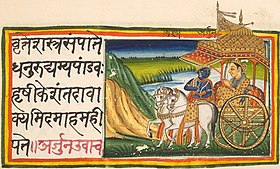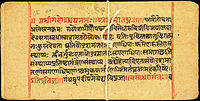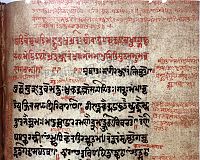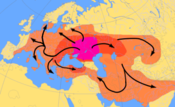
A | B | C | D | E | F | G | H | CH | I | J | K | L | M | N | O | P | Q | R | S | T | U | V | W | X | Y | Z | 0 | 1 | 2 | 3 | 4 | 5 | 6 | 7 | 8 | 9
| Sanskrit | |
|---|---|
| संस्कृत-, Saṃskṛta-, संस्कृतम्, Saṃskṛtam | |
|
(top) A 19th-century illustrated Sanskrit manuscript from the Bhagavad Gita,[1] composed c. 400 – 200 BCE.[2][3] (bottom) The 175th-anniversary stamp of the third-oldest Sanskrit college, Sanskrit College, Calcutta. 1791. | |
| Pronunciation | [ˈsɐ̃skr̩tɐm] |
| Region | South Asia (India proper), Indianised Southeast Asia, Greater Tibet, Greater Mongolia, Central Asia (formerly). |
| Era | c. 1500–600 BCE (Vedic Sanskrit);[4] 700 BCE – 1350 CE (Classical Sanskrit)[5] |
| Revival | There are no known native speakers of Sanskrit.[6][7][8][9][10][11] |
Indo-European
| |
Early form | |
| |
| Official status | |
Official language in |
|
Recognised minority language in | South Africa (protected language)[14] |
| Language codes | |
| ISO 639-1 | sa |
| ISO 639-2 | san |
| ISO 639-3 | san – inclusive codeIndividual codes: cls – Classical Sanskritvsn – Vedic Sanskrit |
| Glottolog | sans1269 |
Sanskrit (/ˈsænskrɪt/; attributively संस्कृत-, saṃskṛta-;[15][16] nominally संस्कृतम्, saṃskṛtam, IPA: [ˈsɐ̃skr̩tɐm][17][b]) is a classical language belonging to the Indo-Aryan branch of the Indo-European languages.[19][20][21] It arose in South Asia after its predecessor languages had diffused there from the northwest in the late Bronze Age.[22][23] Sanskrit is the sacred language of Hinduism, the language of classical Hindu philosophy, and of historical texts of Buddhism and Jainism. It was a link language in ancient and medieval South Asia, and upon transmission of Hindu and Buddhist culture to Southeast Asia, East Asia and Central Asia in the early medieval era, it became a language of religion and high culture, and of the political elites in some of these regions.[24][25] As a result, Sanskrit had a lasting effect on the languages of South Asia, Southeast Asia and East Asia, especially in their formal and learned vocabularies.[26]
Sanskrit generally connotes several Old Indo-Aryan language varieties.[27][28] The most archaic of these is the Vedic Sanskrit found in the Rigveda, a collection of 1,028 hymns composed between 1500 BCE and 1200 BCE by Indo-Aryan tribes migrating east from what is today Afghanistan across northern Pakistan and into northwestern India.[29][30] Vedic Sanskrit interacted with the preexisting ancient languages of the subcontinent, absorbing names of newly encountered plants and animals; in addition, the ancient Dravidian languages influenced Sanskrit's phonology and syntax.[31] Sanskrit can also more narrowly refer to Classical Sanskrit, a refined and standardized grammatical form that emerged in the mid-1st millennium BCE and was codified in the most comprehensive of ancient grammars,[c] the Aṣṭādhyāyī ('Eight chapters') of Pāṇini.[32] The greatest dramatist in Sanskrit, Kālidāsa, wrote in classical Sanskrit, and the foundations of modern arithmetic were first described in classical Sanskrit.[d][33] The two major Sanskrit epics, the Mahābhārata and the Rāmāyaṇa, however, were composed in a range of oral storytelling registers called Epic Sanskrit which was used in northern India between 400 BCE and 300 CE, and roughly contemporary with classical Sanskrit.[34] In the following centuries, Sanskrit became tradition-bound, stopped being learned as a first language, and ultimately stopped developing as a living language.[9]
The hymns of the Rigveda are notably similar to the most archaic poems of the Iranian and Greek language families, the Gathas of old Avestan and Iliad of Homer.[35] As the Rigveda was orally transmitted by methods of memorisation of exceptional complexity, rigour and fidelity,[36][37] as a single text without variant readings,[38] its preserved archaic syntax and morphology are of vital importance in the reconstruction of the common ancestor language Proto-Indo-European.[35] Sanskrit does not have an attested native script: from around the turn of the 1st-millennium CE, it has been written in various Brahmic scripts, and in the modern era most commonly in Devanagari.[a][12][13]
Sanskrit's status, function, and place in India's cultural heritage are recognized by its inclusion in the Constitution of India's Eighth Schedule languages.[39][40] However, despite attempts at revival,[8][41] there are no first-language speakers of Sanskrit in India.[8][10][42] In each of India's recent decennial censuses, several thousand citizens have reported Sanskrit to be their mother tongue,[e] but the numbers are thought to signify a wish to be aligned with the prestige of the language.[6][7][8][43] Sanskrit has been taught in traditional gurukulas since ancient times; it is widely taught today at the secondary school level. The oldest Sanskrit college is the Benares Sanskrit College founded in 1791 during East India Company rule.[44] Sanskrit continues to be widely used as a ceremonial and ritual language in Hindu and Buddhist hymns and chants.
Etymology and nomenclature
In Sanskrit, the verbal adjective sáṃskṛta- is a compound word consisting of sáṃ ('together, good, well, perfected') and kṛta- ('made, formed, work').[45][46] It connotes a work that has been "well prepared, pure and perfect, polished, sacred".[47][48][49] According to Biderman, the perfection contextually being referred to in the etymological origins of the word is its tonal—rather than semantic—qualities. Sound and oral transmission were highly valued qualities in ancient India, and its sages refined the alphabet, the structure of words, and its exacting grammar into a "collection of sounds, a kind of sublime musical mold" as an integral language they called Sanskrit.[46] From the late Vedic period onwards, state Annette Wilke and Oliver Moebus, resonating sound and its musical foundations attracted an "exceptionally large amount of linguistic, philosophical and religious literature" in India. Sound was visualized as "pervading all creation", another representation of the world itself; the "mysterious magnum" of Hindu thought. The search for perfection in thought and the goal of liberation were among the dimensions of sacred sound, and the common thread that wove all ideas and inspirations together became the quest for what the ancient Indians believed to be a perfect language, the "phonocentric episteme" of Sanskrit.[50][51]
Sanskrit as a language competed with numerous, less exact vernacular Indian languages called Prakritic languages (prākṛta-). The term prakrta literally means "original, natural, normal, artless", states Franklin Southworth.[52] The relationship between Prakrit and Sanskrit is found in Indian texts dated to the 1st millennium CE. Patañjali acknowledged that Prakrit is the first language, one instinctively adopted by every child with all its imperfections and later leads to the problems of interpretation and misunderstanding. The purifying structure of the Sanskrit language removes these imperfections. The early Sanskrit grammarian Daṇḍin states, for example, that much in the Prakrit languages is etymologically rooted in Sanskrit, but involves "loss of sounds" and corruptions that result from a "disregard of the grammar". Daṇḍin acknowledged that there are words and confusing structures in Prakrit that thrive independent of Sanskrit. This view is found in the writing of Bharata Muni, the author of the ancient Natya Shastra text. The early Jain scholar Namisādhu acknowledged the difference, but disagreed that the Prakrit language was a corruption of Sanskrit. Namisādhu stated that the Prakrit language was the pūrvam ('came before, origin') and that it came naturally to children, while Sanskrit was a refinement of Prakrit through "purification by grammar".[53]
History
Origin and development
Sanskrit belongs to the Indo-European family of languages. It is one of the three earliest ancient documented languages that arose from a common root language now referred to as Proto-Indo-European:[19][20][21]
- Vedic Sanskrit (c. 1500–500 BCE).
- Mycenaean Greek (c. 1450 BCE)[54] and Ancient Greek (c. 750–400 BCE).
- Hittite (c. 1750–1200 BCE).
Other Indo-European languages distantly related to Sanskrit include archaic and Classical Latin (c. 600 BCE–100 CE, Italic languages), Gothic (archaic Germanic language, c. 350 CE), Old Norse (c. 200 CE and after), Old Avestan (c. late 2nd millennium BCE[55]) and Younger Avestan (c. 900 BCE).[20][21] The closest ancient relatives of Vedic Sanskrit in the Indo-European languages are the Nuristani languages found in the remote Hindu Kush region of northeastern Afghanistan and northwestern Himalayas,[21][56][57] as well as the extinct Avestan and Old Persian – both are Iranian languages.[58][59][60] Sanskrit belongs to the satem group of the Indo-European languages.
Colonial era scholars familiar with Latin and Greek were struck by the resemblance of the Sanskrit language, both in its vocabulary and grammar, to the classical languages of Europe. In The Oxford Introduction to Proto-Indo-European and the Proto-Indo-European World, Mallory and Adams illustrate the resemblance with the following examples of cognate forms[61] (with the addition of Old English for further comparison):
| PIE | English | Old English | Latin | Greek | Sanskrit | Glossary |
|---|---|---|---|---|---|---|
| *méh₂tēr | mother | mōdor | māter | mētēr | mātár- | mother |
| *ph₂tḗr | father | fæder | pater | patēr | pitár- | father |
| *bʰréh₂tēr | brother | brōþor | frāter | phreter | bhrā́tar- | brother |
| *swésōr | sister | sweoster | soror | eor | svásar- | sister |
| *suHnús | son | sunu | - | hyiós | sūnú- | son |
| *dʰugh₂tḗr | daughter | dohtor | - | thugátēr | duhitár- | daughter |
| *gʷṓws | cow | cū | bōs | bous | gáu- | cow |
| *demh₂- | tame, timber | tam, timber | domus | dom- | dām- | Zdroj:https://en.wikipedia.org?pojem=ISO_639:san






